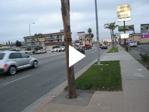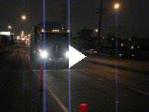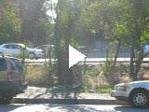Summary: Cars are scary, my passport was stolen, and I’m stuck in San Diego till I get a new one.
Full account: After visiting Environmental Charter school Monday morning (see next entry), I found the closest bike store and asked for dirctions to highway one. They did not know any good ways to bike there, and I followed a busy street with no bike lane.
At highway one, which has green signs reading ‘bike route,’ I found myself comfortable biking only on the sidewalk as rush hour traffic filled the three lanes. Traveling slowly, I stopped many miles short of a campground and was forced to stay at a cheap hotel near the intersection of two highways. (Watch the movie on the left if you have a high speed connection).
I departed at little after 5 the next morning to avoid rush hour, and soon biked in the dark through steaming oil refineries and petroleum-smelling air. As the dawn came, I made it to Huntington Beach and Newport Beach, and found a bike lane and shoulder along the roadside.
A tailwind blew, and other than a few busy towns, the riding was easy. In Camp Pendleton marine base, I stopped at a small convenience store, and, as usual, brought my bike into the store and left it within sight of the cash register. While talking with a marine outside, I must have left my wallet, with passport and drivers license, at the bicycle. In a few minutes, it was gone.
Perhaps my guard was too low because I was still in the U.S., or my blood sugar wasn’t high enough to keep track of my stuff. My anger is mixed with feelings of frustration and ineptitude, and I hope I can use this as a lesson to keep better track of my stuff as I travel south. I am about to buy a better bike lock.
Soon, two other cyclists with loaded bicycles pulled up to the store. The two friends, Gregg and Brooks, started in July in Alaska and are also riding to southern Argentina. They are raising money for diabetes research, and have a great website. We rode the last 15 miles to a campground in Encinitas, and talked about the road behind and ahead: What did you hear about that dirt road in Baja? (great but hard) Are you biking Colombia? (maybe) How will you get through the rest of Mexico? (go inland) When will you finish? (November 2006) What has broken on your bike so far? (frame, wheel rim) Have you run into others on this route? (Yes, at least one other group.)
After sharing a campsite, I said goodbye to Gregg and Brooks the next morning. They will ride far ahead of me in Baja while I get a new passport, but I am sure our paths will cross again. I then biked 15 miles to San Diego, where I will stay with my friend Sheila Walsh until I get a new passport.







